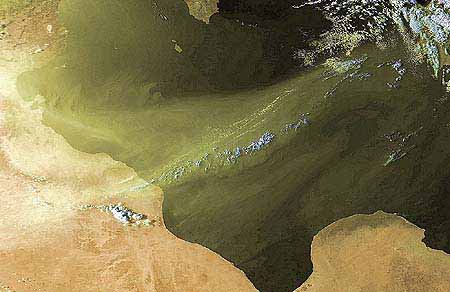|
Winds
of the Mediterranean: Sirocco and Mistral
BY Wijke Ruiter
Who wouldn't like the azury blue Med; with
its azury blue sky; heavenly climate
and lovely sea water; reasons enough for a lazy beach day.
But ever
thought of playing golf during the siesta?
"Summer
time golf? I t
hadnít crossed my mind. My three visits had all been in winter and I
presumed,
misguidedly, that summer would be blood-boiling time and too hot. t
hadnít crossed my mind. My three visits had all been in winter and I
presumed,
misguidedly, that summer would be blood-boiling time and too hot.
Not so, I learned recently. The year-round average temperature is
pleasant.
Aside from the occasional Sirocco, a hot and muscular wind from Africa
which
announces itself three or four times a year and takes four days to run
its
course, the breeze is a cooling one. Itís just strong enough to make
golf
interesting and takes the heat out of the sun on the days
that bring the
occasional scorcher."
According
to tourist guides, the Mediterranean
must be paradise. Even for golfers.
They conceal the disaster the unreliable climate can bring.
The winds of the Med we discuss here will be two different ones. The
first is a
hot and strong wind from the Sahara and the other one is a cool wind
coming down
from the mountains. The winds mostly have different local names, but
they often
have the same origin.
Sirocco;
hot wind from the Desert.
De Sirocco is a southerly, which develops when a low above the
Mediterranean
moves east. This Med-low draws hot air from a large area of the
Northern Sahara;
it moves north and will finally meet the air above the sea, which is
about 10
įC cooler; but far more humid.
When these two air masses meet, fronts with heavy rain- and
thunderstorms can
develop and the winds can reach forces about 40 to 50 knots; that's up
to force
10 at the Beaufort-scale.
De
Sirocco is famous not only because of the
heavy rain and damaging storms; but it can also bring sand from the
Sahara;
spreading widely over the European continent. This sand comes down with
the
rain; sometimes even in Holland.
Apart from these effects the Sirocco also can affect health.
The sudden
change of temperature and humidity can be very depressing for a lot of
people;
causing headaches and sleeping
problems
The Sirocco mostly occurs during the springtime - from February to July
- but
also can develop in other times of the year.
Sirocco in Libya
Libya also has its famous desert storms. A southerly, dry and
hot wind
comparable with the Sirocco. The Libyans call it: Ghibli.
This wind brings dust and sand; the sky is red to brown and the
visibility can
lower to less than 30 meters.
Libya has no natural barriers, so this wind can spread through the
whole
country. When Ghibli reaches the Mediterranean the
temperature there can
suddenly rise from 40 to 50įC and the humidity lower from 80 to 10 %.
The Ghibli can last one to four days. During this period normal life is
hardly
possible.
Fortunately this desert storm can be well predicted; it always occurs
when
there's a deep low above the Med.
The Mistral; a cold
mountain wind.
De Mistral is a northerly downwind in the South of France. It can
easily reach hurricane force
and in wintertime it can bring freezing temperatures - below zero
- to the
French Riviera. De Mistral develops when cold air masses from
the North pole
moves far south into Europe. A low above the much warmer Med will force
this
cold air to flow more south along the French Alps into the Rhone
valley. This
valley acts as a natural wind tunnel which increases wind force;
sometimes to 10
or 11 Beaufort.
With a Mistral outburst the sea can chance into a raving eddy; with
huge
thundering breakers. When the cold and warm air masses meet above the
sea; heavy
rain- and thunderstorm can develop.
The Mistral can linger for about 4 days; even at night - when the
temperature
differences decline, this wind can roar heavily; bringing lots of dust.
Its
imaginable that animals but also people - however used to the
phenomenon - can
get very nervous; and really relieved when the storm is over.
wijke@scribeweekly.com
|

 t
hadnít crossed my mind. My three visits had all been in winter and I
presumed,
misguidedly, that summer would be blood-boiling time and too hot.
t
hadnít crossed my mind. My three visits had all been in winter and I
presumed,
misguidedly, that summer would be blood-boiling time and too hot.
